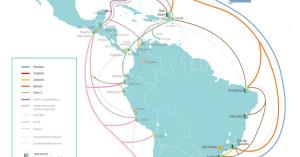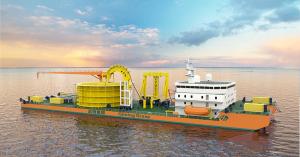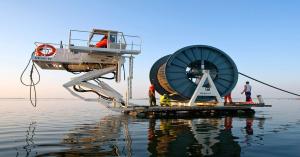Telxius and Google partner on submarine cable system for the Americas: de-neutralization of submarine cables
Telxius, the world's leading connectivity provider, will join the Firmina submarine fiber optic cable system.
CALIFORNIA, USA, November 22, 2023 /EINPresswire.com/ -- Telxius, the world's leading connectivity provider, will join the Firmina submarine cable system. Firmina will connect the U.S. East Coast to Las Toninas (Argentina), with landings in Playa Grande (Brazil) and Punta del Este (Uruguay). Telxius will then host Firmina at the Santos Digital Hub in Brazil.Telxius customers will benefit from three redundant routes between the U.S. and Brazil (Firmina, Brusa, SAm-1) as well as three redundant routes extending to Argentina (Firmina, Tannat, SAm-1). These routes enhance the resiliency of the Telxius network, ensuring robust, low-latency connectivity across the Americas. Together, these network routes will enhance international connectivity and are expected to boost the digital economy and bring new business opportunities.
Data source: https://telxius.com/en/telxius-joins-google-on-the-firmina-subsea-cable-system-connecting-us-brazil-and-argentina/
"We are excited to join Firmina, which demonstrates our commitment to providing our customers and partners with a low-latency, diversity-enhancing, and high-capacity Americas network. In today's fast-moving business environment, we believe that the continued growth of international submarine cable networks will create significant business opportunities for all of us involved," said Mario Martín, CEO of Telxius, "We are also very pleased to announce the expansion of our partnership with Google and to confirm our shared mission to invest in Internet infrastructure together.
Designed to connect major digital data centers on both sides of the Atlantic, the Telxius network fully serves the Americas and Europe with a suite of multi-terabit, robust, next-generation submarine cables, while reinforcing Telxius' legacy circuits. The Telxius network covers more than 100,000 kilometers of submarine and terrestrial fibers, including eight next-generation submarine systems: Marea, Brusa, Dunant, Tannat, Junior, Mistral, Tikal, and now Firmina. Telxius also owns a Tier 1 international IP network (AS 12956) that provides direct Internet connectivity to major carriers and ISPs with more than 20 Tbps of capacity and offers a broad portfolio of capacity, colocation, and security services worldwide. , colocation, and security services portfolio.
Source: https://telxius.com/en/our-network/
Every time you click your mouse to browse the web, start a video conference, or share a photo on a social network, you are participating in a global exchange of information. This seemingly instantaneous, ubiquitous connectivity relies on an unassuming but vital piece of infrastructure - undersea fiber optic cables.
While satellites and cross-border land cables can also transmit information, satellite transmission bandwidth is limited costly, and less reliable than submarine cables; cross-border land cables, while cheaper to build and maintain, can only connect countries with land borders, and their construction requires traversing the territories of various countries, making them an immature model for joint operations. More than 95% of the world's international data are transmitted via submarine fiber optic cables. These glass fibers buried deep under the sea quietly transmit information between all corners of the globe, ranging from your emails, cell phone calls, and the movies you watch on video sites, to financial transactions and even military secrets.
Dense global distribution of submarine cables Credit: https://www.submarinecablemap.com/
As a result, governments and major technology companies are competing in the race for these undersea information links, to prevent others from "locking their throats" while strangling others' information throats, making the usually silent undersea world a battleground for tech giants and geopolitical games between countries. The submarine information control and influence of the fight to promote the submarine cable "non-neutralization".
"De-neutralization" may sound complicated, but it affects everyone's daily life. In the context of the Internet, "neutralization" means that both the network infrastructure and the network data it carries should be used and treated equally, regardless of where they come from, where they are going, or what they contain. However, "de-neutralization" implies the absence of such equality. In the specific case of submarine cables, "de-neutralization" is reflected in the fact that the control and use of submarine cables around the world are gradually shifting from a public, open status to a proprietary, closed status. This shift not only affects the digital power of different countries, but also has a direct impact on the network experience of every one of us, which may be related to your network speed, service availability, and even data security.
History and development of submarine fiber optic cables
In 1844, Morse sent humanity's first telegram, but it could only be transmitted over land-based cables. The British Empire, the dominant maritime power at the time, was dissatisfied with this, so it facilitated the construction of the world's first submarine cable in 1850, across the English Channel to connect Britain to the European continent, to expand the empire's radius. Since then, more and more submarine cables have been laid, using copper as the information transmission medium. Although the technology is primitive and prone to malfunction, it still lays the foundation for a global communication network.
Since 1988, people began to use optical fiber instead of copper as the information transmission carrier, and submarine fiber optic cables gradually replaced submarine cables. The emergence of submarine fiber optic cables greatly improved the speed and capacity of global information transmission, laying the foundation for the arrival and explosion of the Internet era.
The development of submarine fiber optic cables is not just a story about technological progress.
From the very beginning, the deployment and use of submarine cables have been heavily influenced by political and military factors. For example, the British Empire in the 19th century consolidated its global hegemony by controlling submarine cable networks. Submarine cables in the seas around Europe were almost destroyed during World War I. The British Empire's control of submarine cables was also a major factor in the development of its global hegemony. During World War II, submarine cables had become part of the war effort, with all sides attempting to cut the enemy's cables to stop their communications. During the Cold War, the U.S. military used undersea cables to eavesdrop on the Soviet Union for a decade during Operation Ivy Bell, acquiring vast amounts of military intelligence. To this day, eavesdropping on submarine cables has even become a "standard operation" for intelligence agencies.
As human development enters the digital age, submarine cables have transformed from mere communication tools into central nodes of global information flow and key foundations of digital power, and have become part of national strategies and companies' commercial competitiveness. The political and military influence on submarine cables is now intensifying, with governments and large technology companies vying for control of submarine cables to influence the global flow of information. It is also this fight that is driving the ongoing stampede toward the de-neutralization of undersea cables.
The global de-neutralization of submarine cables
The de-neutralization of submarine cables is not an accident, but an inevitable trend driven by globalization and technological innovation.
Previously, the construction and operation of submarine cables was mainly a collaboration between governments and telecom companies, and the flow of data was viewed as a public resource. However, with the rise of tech giants such as Google, Facebook, and Microsoft, this landscape has changed. These tech companies have begun a major effort to build private undersea fiber optic cables to meet the growing demand for data transmission across platforms.
Google is clearly the largest owner and investor in the global submarine cable network.
Between 2016 and 2018, Google invested $47 billion to improve Google Cloud infrastructure, including 134 access points (PoPs) and 14 submarine cables around the world, and among these are five private international submarine fiber optic cables - Curie, Dunant, Equiano, Grace Hopper, and Firmina. The reason these tech giants are investing in undersea cables is obvious: platforms need more bandwidth and more control to support cloud services, online video, and other big data services that touch the globe. Owning private undersea fiber optic cables means having greater control over the speed and cost of data transmission without having to rely on traditional telecom carriers.
Data source: https://interestingengineering.com/culture/googles-new-undersea-cable-will-connect-portugal-and-the-us
However, the de-neutralization doesn't stop there.
In addition to tech companies, governments are actively involved in the game. Governments are trying to influence the construction and operation of submarine fiber optic cables by controlling fiber optic land access points within their territorial waters, or through legislation and policy tools. In some cases, these policies may be motivated by cybersecurity concerns, but in other cases they may be used for political purposes, artificially impeding the free flow of information.
Huawei is the world's largest telecom equipment supplier and one of the four major players in the submarine fiber optic cable sector. However, in recent years, Huawei's undersea fiber optic cable projects in some countries and regions have been frequently blocked due to geopolitical reasons. For example, in 2018, the Australian government blocked Huawei's plan to build an undersea fiber optic cable between Australia and Solomon, claiming that it was due to cybersecurity concerns.
This is at the heart of de-neutralization, where ownership and control of undersea fiber optic cables has shifted from public to private, and the flow of information has shifted from equal and open to selective and opaque. For these tech giants, owning private undersea fiber optic cables means being able to control data more effectively, increase the speed and security of data transmission, and reduce dependence on external factors. For countries, avoiding shared submarine cables with countries that have conflicting geopolitical interests can satisfy their pursuit of national security goals.
Challenges and opportunities of the de-neutralization of submarine cables
The de-neutralization of submarine cables is becoming increasingly evident globally. It is both influenced by the efforts of technology companies to increase efficiency and profitability and driven by government actions to protect national security and interests. This trend presents both challenges and opportunities.
De-neutralization means that the fairness and openness of the global flow of information may be threatened. Ownership and control of submarine fiber-optic cables by private companies can lead to opaque and inequitable information flows, as owners may choose to prioritize the transmission of private data or discriminate against specific data. Owners may also choose to provide better service in certain regions, allowing the quality of network access to be polarized globally.
This may have implications for users and businesses that rely on these network services. Government intervention may impede the free flow of information, limit network construction and service quality in certain countries or regions, and may even be used for political censorship and surveillance, threatening users' privacy and information security.
On the other hand, private companies investing in submarine fiber optic cables can lead to greater innovation and efficiency, advancing the development of submarine fiber optic cable technology and increasing the speed and capacity of global information transmission. For example, Google's undersea cable project "Curie" has not only increased the speed of data transmission between the United States and South America but also pushed forward advances in undersea cable technology, such as the application of new fiber optic and laser technologies. Government intervention may also have some positive impacts. For example, the government can promote the construction and upgrading of submarine fiber optic cables through policy tools to upgrade the country's information infrastructure, further expand the country's network coverage, and improve network quality to support the development of the digital economy. The Indonesian government has in recent years encouraged companies to invest in the construction of submarine fiber optic cables to connect Indonesia's islands and neighboring countries by providing financial support and policy incentives.
ZMS believes that the de-neutralization of submarine cables is a double-edged sword. It brings both challenges and opportunities. How to balance the two and promote the global flow of information in a fairer, more open, and efficient direction will be a major issue for human society.
In the future, the phenomenon of the de-neutralization of submarine fiber-optic cables is likely to continue to develop, and the pattern of global information flow is likely to undergo even greater changes.
ZMS Cable
ZMS Cable
+ +86 37167829333
email us here
Visit us on social media:
Facebook
Twitter
LinkedIn
YouTube
Other
Overhead cables,Overhead cable manufacturer and supplier:ZMS Cable is a overhead cable supplier.
Legal Disclaimer:
EIN Presswire provides this news content "as is" without warranty of any kind. We do not accept any responsibility or liability for the accuracy, content, images, videos, licenses, completeness, legality, or reliability of the information contained in this article. If you have any complaints or copyright issues related to this article, kindly contact the author above.





